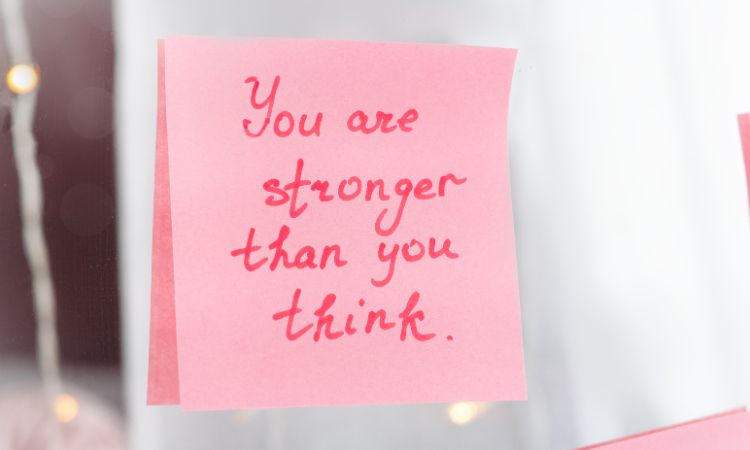Have you ever felt like an invisible force was holding you back from achieving your dreams?
Limiting beliefs are thoughts, convictions, or opinions that you believe are absolute truths and prevent you from doing certain things. They can be about yourself, the world, ideas, or how you interact with people.
Some examples of limiting beliefs include:
- “I’m not good enough.”
- “I’m too old or too young.”
- “I don’t have enough time.”
- “I’m not smart enough.”
- “I don’t have enough experience.”
- “I’ll never be successful.”
- “I’ll never be one of the best.”
- “I’m not talented enough.”
- “I’ll never be a great leader.”
These persistent, self-sabotaging thoughts act like invisible boundaries, keeping us confined within a comfort zone that’s often far smaller than our true potential.
But there’s good news. No matter how long-standing or deeply rooted, these beliefs are not set in stone. With awareness, dedication, and the right tools, you can identify, challenge, and begin to overcome these self-imposed restrictions.
By doing so, you can unlock new levels of personal growth, achievement, and fulfillment that you might have previously thought impossible.
In this article, we’ll explore what limiting beliefs are, where they come from, and how they impact our lives.
Most importantly, we’ll provide you with a practical, step-by-step guide to recognizing and overcoming your own limiting beliefs.
What Are Limiting Beliefs?

Limiting beliefs are deeply ingrained convictions or assumptions about ourselves, others, or the world that constrain our thinking, behavior, and potential.
These beliefs act as mental barriers, often operating at a subconscious level, preventing us from reaching our full potential or pursuing our goals and desires.
A limiting belief can be defined as “a thought or state of mind that you think is the absolute truth and stops you from doing certain things.”
It’s important to note that these beliefs don’t always have to be about ourselves; they can also be about how the world works, ideas, or how we interact with people.
Common limiting beliefs typically manifest in three main categories:
- Beliefs about yourself: These are thoughts like “I’m not smart enough” or “I don’t have what it takes to succeed.”
- Beliefs about the world: These include ideas such as “The job market is too competitive” or “People can’t be trusted.”
- Beliefs about life in general: These are broader concepts like “Life is a struggle” or “Success requires sacrificing everything else.”
They can manifest in various ways, such as excuses, justifications, worries, perfectionist thinking, or fears.
What makes these negative beliefs particularly challenging is that we often treat them as absolute truths, even when there’s little or no evidence to support them.
They can be formed unconsciously, often as a result of past experiences, and tend to have a negativity bias – meaning we’re more likely to assume we can’t do something rather than assuming we can.
It’s crucial to understand that while some self-limiting beliefs might have served as protective mechanisms in the past, they can become outdated and unhelpful in our current circumstances.
Recognizing and challenging these beliefs is the first step towards personal growth and achieving our full potential.
Where Do Limiting Beliefs Come From?
Limiting beliefs typically originate from various sources throughout our lives. Understanding these origins can help us identify and address them more effectively.
Childhood Experiences
Many limiting beliefs are formed during childhood, a critical period for cognitive and emotional development. Negative experiences, such as criticism from parents or teachers, can instill beliefs like “I’m not good enough” or “I don’t deserve success.”
These early messages can become deeply ingrained and persist into adulthood.
Cultural Influences
Societal norms and cultural expectations also play a significant role in shaping our beliefs. Cultural messages about gender roles, socioeconomic status, and other identity factors can create limiting beliefs.
For example, cultural stereotypes might lead someone to believe, “People like me don’t achieve high levels of success,” which can hinder their ambitions.
Past Failures or Traumas
Experiences of failure or trauma can reinforce limiting beliefs. If someone has faced repeated setbacks or traumatic events, they might develop beliefs such as “I’m destined to fail” or “The world is a dangerous place.”
These beliefs can create a cycle of fear and avoidance, preventing personal growth and progress.
How Limiting Beliefs Can Impact Your Life
Limiting beliefs can have a profound and far-reaching impact on various aspects of our lives. Understanding the effects of these negative thoughts is crucial in helping to identify limiting beliefs and overcome them.
Our Beliefs Shape Our Reality
Our beliefs act as filters through which we perceive and interpret the world around us.
Limiting beliefs can significantly distort this perception, causing us to see situations, opportunities, and even our own capabilities in a negative or restricted light. This altered perception can lead to a self-imposed narrowing of our experiences and potential.
For example, if you believe “I’m not creative,” you might avoid creative growth, projects, or innovative problem-solving, effectively shutting yourself off from a whole realm of personal and professional growth.

This negative belief doesn’t just affect your actions; it shapes your entire reality, making you less likely to notice or appreciate creative opportunities when they arise.
Self-Fulfilling Prophecies
Because this belief that you are not creative makes you avoid creative opportunities in the future, it becomes a self-fulfilling prophecy.
When we deeply believe something about ourselves or the world, we often unconsciously act in ways that make that belief come true.
If you believe that you’re terrible at public speaking, you might avoid opportunities to speak in public, never seek to improve your skills, or become extremely nervous when forced to present.
This behavior then reinforces their original belief, creating a cycle that’s difficult to break.
Missed Opportunities and Stunted Growth
All of these missed opportunities can lead to less professional and personal growth.
When we believe we’re incapable of achieving something, we’re less likely to try, and therefore less likely to succeed or grow.
If you believe that you are “not cut out for starting a new business,” you might pass up on exciting opportunities or fail to acquire new skills that could lead to career advancement. This self-imposed limitation not only affects your career trajectory but also your personal development and happiness.
Emotional and Psychological Effects

The impact of limiting beliefs extends beyond tangible outcomes to affect our emotional and psychological well-being.
Constantly holding negative beliefs about oneself or the world can lead to:
- Low self-esteem and lack of confidence
- Increased anxiety and stress
- Depression and feelings of hopelessness
- Chronic dissatisfaction with life
- Imposter syndrome in professional settings
These emotional effects can create a negative feedback loop, further reinforcing our beliefs and making them even harder to overcome.
Impact on Decision-Making and Risk-Taking
Limiting beliefs can significantly influence our decision-making processes and our willingness to take risks.
When we believe our options are limited or that we’re incapable of handling challenges, we tend to make decisions based on fear rather than potential.
This risk-averse mindset can lead to:
- Staying in unfulfilling jobs or relationships out of fear of change
- Not pursuing educational or career advancements
- Avoiding new experiences or challenges that could lead to personal growth
- Making financial decisions based on scarcity rather than abundance
- Hesitating to express opinions or ideas in professional or social settings
By constraining our decision-making and risk-taking, limiting beliefs can prevent us from living life to its fullest potential and experiencing the growth that comes from stepping outside our comfort zones.
Other Areas of Life at Risk
Here are some common areas of life where self-limiting beliefs manifest:
- Self-Worth: Thoughts like “I’m not worthy of love” or “I’m not talented enough” can erode self-esteem and hinder personal development.
- Relationships: Beliefs such as “I don’t deserve a healthy relationship” or “People will always let me down” can lead to patterns of distrust, isolation, or unhealthy relationship dynamics.
- Career and Success: Thoughts like “I’m not qualified for that promotion” or “I can’t start my own business” can prevent you from pursuing career advancements or entrepreneurial ventures.
- Money and Abundance: Ideas like “Money is the root of all evil” or “I will never be financially secure” can create a scarcity mindset, affecting financial decisions and opportunities.
- Health and Well-Being: Thoughts like “I’ll never be fit and healthy” or “I can’t overcome this illness” can negatively impact your physical and mental health.
By recognizing these mental barriers, we can begin to challenge and change them, opening the door to greater possibilities and personal growth.
How to Identify Your Limiting Beliefs
Identifying common limiting beliefs in your life is an important first step to overcoming them. Often, these beliefs are so ingrained that we may not even be aware of their presence or influence.
Here are several effective methods to help you identify your limiting beliefs:
Self-Reflection Techniques
Self-reflection is a powerful tool to identify self-limiting beliefs. Set aside quiet time regularly to introspect and examine your thoughts, feelings, and behaviors. Ask yourself:
- What areas of my life do I feel stuck or dissatisfied with?
- What goals have I been hesitant to pursue, and why?
- What negative self-talk do I engage in most frequently?
- In what situations do I feel most insecure or inadequate?
By diving deep into these questions, you can start to uncover the underlying beliefs that may be holding you back.
Common Signs of Limiting Beliefs
Limiting beliefs often manifest in specific patterns of thought and behavior. Look out for these common signs:
- Procrastination or avoidance of certain tasks or situations
- Frequent use of “should” statements (e.g., “I should be better at this by now”)
- All-or-nothing thinking (e.g., “If I can’t do it perfectly, there’s no point in trying”)
- Excessive self-criticism or negative self-talk
- Feeling consistently overwhelmed or incapable in specific areas of life
- Making excuses or rationalizing why you can’t do something
Recognizing these patterns can help you identify the beliefs behind them.
Journaling Exercises

Journaling is an excellent way to explore your thoughts and uncover limiting beliefs. Try these exercises:
- Stream of Consciousness Writing: Write freely for 10-15 minutes without censoring yourself. Look for recurring themes or negative patterns in your writing.
- Belief Inventory: List out your beliefs about different areas of life (e.g., relationships, career, money). Challenge each belief by asking, “Is this really true? Where did this belief come from?”
- Goal Obstacle Analysis: Write down a goal you’ve been struggling to achieve. List all the reasons you think you can’t achieve it. These reasons often point to underlying limiting beliefs.
Seeking Feedback from Others
Sometimes, others can see our limiting beliefs more clearly than we can. Seek honest feedback from trusted friends, family members, or colleagues. Ask them:
- What potential do they see in you that you might not recognize?
- Have they noticed any self-sabotaging behaviors or negative patterns in your actions?
- What do they think might be holding you back from achieving your goals?
Be open to their perspectives, as they may provide valuable insights into beliefs you’ve been blind to.
Professional Help: Therapy and Coaching
If you’re finding it challenging to identify these beliefs on your own, consider seeking professional help. Therapists and life coaches are trained to help you uncover and address limiting beliefs. They can provide:
- Objective perspectives on your thought patterns and behaviors
- Specialized techniques to uncover deep-seated beliefs
- Guidance in challenging and reframing limiting beliefs
- Support in developing new, empowering beliefs
Remember that this is an ongoing process. As you grow and evolve, new limiting beliefs may surface, while others may lose their grip. Regular self-reflection and openness to feedback are key to continually identifying and addressing these beliefs.
5 Steps to Overcome Limiting Beliefs
Once you’ve identified your limiting beliefs, it’s time to take action to overcome them. This process requires patience, persistence, deliberate practice, and self-compassion.
Here are five powerful steps to help you break free from your limited mindset and embrace a more empowering mindset.
1, Awareness and Acknowledgment
The first step in overcoming limiting beliefs is to become fully aware of them and acknowledge their presence in your life.
Recognize Limiting Beliefs in Action

Pay close attention to your negative thoughts and behaviors throughout the day. Notice when negative self-talk arises or when you hesitate to take action due to self-doubt. These moments are your limiting beliefs at work.
Practice mindfulness to catch these thoughts as they arise. You might say to yourself, “I notice I’m having the thought that I’m not good enough for this job.” This creates a separation between you and the belief, allowing you to observe it more objectively.
Accept Responsibility for Your Beliefs
It’s crucial to understand that while you may not have chosen your own limiting beliefs initially, you have the power to change them. Take responsibility for your beliefs and their impact on your life.
This shift from victim mentality to personal accountability is empowering and sets the stage for change.
Acknowledge that your beliefs are not facts, but interpretations that you’ve accepted over time. This realization opens the door to questioning and changing these beliefs.
2. Challenge and Question
Once you’re aware of your limiting beliefs, it’s time to challenge them head-on.
Examine the Evidence
Treat your limiting belief like a hypothesis and look for evidence that supports or contradicts it. Ask yourself:
- What concrete evidence do I have that this belief is true?
- Are there any examples from my life that contradict this belief?
- If a friend held this belief about themselves, what would I say to them?
Often, you’ll find that the evidence supporting your limiting belief is weak or based on outdated experiences.
Consider Alternative Perspectives
Challenge yourself to consider different viewpoints and alternative beliefs.
How might someone else interpret the same situations or experiences that led to your limiting belief? Seek out perspectives from people you trust or admire.
Try to imagine how your life might be different if you didn’t hold this belief. This exercise can help you see the possibilities that your limiting belief might be obscuring.
3. Reframe and Replace
After challenging your limiting beliefs, it’s time to reframe them into more empowering alternatives.
Replace Limiting Beliefs With Empowering Beliefs
For each limiting belief you’ve identified, create a new, empowering belief that contradicts it. For example:
- Limiting Belief: “I’m too old to start a new career.”
- Empowering Belief: “My experience and wisdom make me a valuable asset in any field.”
Ensure your new beliefs are realistic and aligned with your values. They should feel stretching but not completely unbelievable.
Positive Affirmations and Self-Talk

Use positive affirmations to reinforce your new, empowering beliefs. Repeat these affirmations daily, especially when you notice the old limiting belief trying to resurface.
Practice compassionate self-talk. When you catch yourself in negative self-talk, pause and reframe it in a kind, encouraging way.
4. Take Action and Gather Evidence
Beliefs are reinforced by actions and experiences. To solidify your new empowering beliefs, you need to act on them.
Set Small, Achievable Goals
Break down your larger goals into small, manageable steps that align with your new beliefs. Each small success will provide evidence for your new belief and build your confidence.
For instance, if your new belief is “I am capable of learning new skills,” set a goal to spend 15 minutes each day learning something new in your field of interest.
Celebrate Successes and Learn from Setbacks
Acknowledge and celebrate every success, no matter how small. This reinforces your new belief and builds momentum.
When you face setbacks, view them as learning opportunities rather than confirmations of your old limiting beliefs. Ask yourself, “What can I learn from this experience?” and “How can I approach this differently next time?”
5. Cultivate a Growth Mindset
The final step in overcoming limiting beliefs is to adopt a growth mindset – the belief that your abilities and intelligence can be developed through effort, learning, and persistence.
Embrace Challenges and Learning Opportunities
See challenges as opportunities for growth rather than threats. Embrace the learning process and focus on progress rather than perfection.
Seek out new experiences and challenges that stretch your comfort zone. Each time you overcome a challenge, you’re providing evidence against your limiting beliefs and for your new, empowering ones.

Develop Resilience and Perseverance
Build resilience by reframing failures as temporary setbacks and learning experiences. Cultivate perseverance by committing to your goals and new beliefs, even when progress feels slow.
Remember, overcoming limiting beliefs is a journey, not a destination. Be patient with yourself and celebrate the progress you make along the way. With consistent effort and practice, you can replace your limiting beliefs with empowering ones, opening up a world of new possibilities and potential.
FAQs About Limiting Beliefs
Conclusion
Limiting beliefs can be powerful obstacles on our path to personal growth and success, but they are not insurmountable. By understanding what limiting beliefs are, recognizing their impact, and learning to identify them in your life, you can start to break free from their constraints.
The journey to overcome limiting beliefs – self-awareness, challenging, reframing, taking action, and cultivating positive thinking and a growth mindset – can help you begin to dismantle the mental barriers that have been holding you back.
Remember, this is a process that requires patience, persistence, and self-compassion.
Some of these beliefs may also be more deeply rooted than others, so don’t be discouraged if the process is harder for some beliefs than others. Each small victory in challenging and changing these beliefs is a step towards a more empowered and fulfilling life.
Seek help and accountability when you need it, but remember that you have everything inside of you to overcome your limiting beliefs and create the life that you want to live. You can discover strengths you never knew you had, pursue opportunities you once thought were out of reach, and achieve goals that previously seemed impossible.
Your potential is limitless!